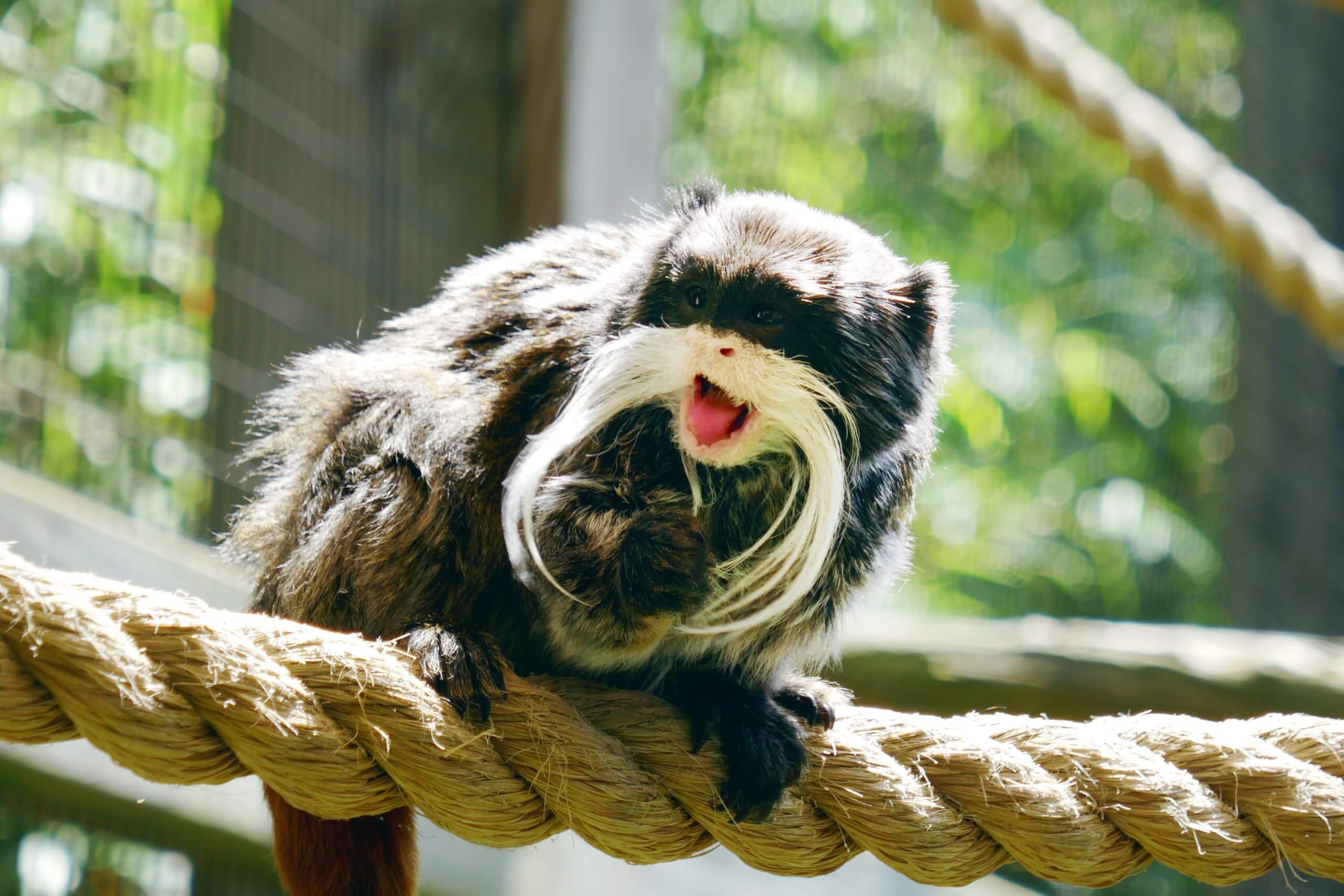COURT HOUSE – There’s always conflict — biting, arguing, slapping — in the primate habitats at the Cape May County Zoo. Kim Simpkins, the senior animal keeper who watches over the zoo’s tamarins, howler monkeys, lemurs, marmosets, De Brazza’s monkeys and siamangs, says this is normal, but gosh if it isn’t a whole lot of work.
“It’s drama — it’s a lot of split-second decision-making,” she told the Herald behind the “tamarin row” on a breezy spring afternoon at the zoo.
Primates are naturally rowdy and live in groups. Their social relationships are more similar to humans than any other animal’s, and like humans, the more personalities involved the more complicated the interpersonal dynamics become.
“It takes a lot out of us to see all the conflict — we just saw one female beating up her younger sister. But it’s natural, this is how they behave in the wild. We do something when it gets out of hand, but we have to find that line,” Simpkins said.
Still, there are many peaceful moments among the primates. They depend on each other and enjoy one another’s company most of the time.
Tamarins are the smallest primates at the zoo. Simpkins fed a small treat to Francois, an emperor tamarin who currently lives by himself while he waits for a partner, or friend, who would transfer from another zoo.
It can take a while for rarer animals like Francois to find a new partner when they are left alone after the death or transfer of a friend. Each animal’s species survival plan dictates who is transferred where, and which member of a species is a good genetic match for another.


Jimmy, a golden-headed lion tamarin, was transferred from the Cape May County Zoo to Buttonwood Zoo in Massachusetts on Monday, June 17, because he found himself alone. It was unlikely that another tamarin could be transferred to the Cape. He was paired with a female in Massachusetts; Simpkins drove six hours each way to bring Jimmy to his new home.
Simpkins can get up close with tamarins because they are small and unlikely to cause physical harm to zookeepers. But she is sure to wear gloves and a mask, as common diseases like herpes can transfer easily between primate and human.
She also gets up close to lemurs, but she tries to limit contact like petting or direct touching lest guests see the casual interaction and think they might make good pets. Indeed, many of the animals at the zoo were former exotic pets that their owners could not properly care for.

Lily is one such, a spotted-tail lemur. She is 18 years old and doing great at the zoo, but she bit her previous owner’s son after being confined indoors. Lemurs can live more than 30 years if properly cared for in places like wildlife refuges and zoos.
Spotted-tail lemurs use their tails like flags. They live in large social groups, and the leader will often raise a tail so others can follow along.


Female lemurs, despite being a similar size to the males, are dominant. “It’s a rare thing for the female members of a species to be the dominant ones. It’s amazing, and part of what makes lemurs so special,” Simpkins said.
Each primate has “enrichment” time twice a day. One enrichment activity for the lemurs is “stations,” where Simpkins lays out three distinctly colored mats. The lemurs — this day Kim trained with Thea, Darwin and Momo — know which color is theirs, and when they all sit on their mats in the proper order, they are given a treat. Lemurs also know their names, as does every primate at the zoo.
“Lemurs are a little bit less intelligent than some of our other primates, but they’re very easily trained — they know the most behaviors out of any species in the zoo,” Simpkins said.

Enrichment is distinct from training, which also takes place every day. Training gets animals ready for important aspects of care, like getting their vaccines and shots, that might otherwise make them uncomfortable.
Simpkins led Thea into a small, box-like enclosure with mesh on one side. She fed him through the mesh and gave him a few pokes with her finger. One day, Thea will do this same training exercise, but she will give him one of his necessary shots. He might not even notice it, but that’s because his training puts him in the perfect position to receive a quick prick.
Though the tamarins, marmosets and lemurs are relatively friendly, the zoo’s larger primates are strong and aggressive. Animal keepers at the zoo never enter the howler monkey, siamang, or De Brazza’s monkey enclosures.
Even the howler monkey, which has weak hands, can do a lot of damage when it wants to. Ed Runyon, director of the zoo’s grounds and the county’s parks, said that their prehensile tails have viselike strength.
The zoo’s De Brazza’s monkeys, Fry and Tot, are highly territorial and will sometimes try to scratch zookeepers if they get too close to their mesh fencing. Simpkins laughed while saying Fry is not quite as smart as his sister, Tot.
“It takes him a bit longer to learn stuff in training,” she said. “And Tot just wants to fight everyone.”
De Brazza’s store food in pouches that sit on the side of their throats. “They can fit an entire banana, peel and all, in there,” she said. She once dropped her phone in their enclosure, which the monkeys quickly stole and only returned when offered a banana.
Sugary foods like bananas are limited in a monkey’s diet; they can get diabetes if given too much sugar, Simpkins said.
Despite their aggressive demeanor, De Brazza’s are threatened in the wild because of the illegal pet trade, overhunting and, most of all, intense habitat loss.
Habitat loss affects nearly every species on Earth, but is especially bad for island-native animals like the zoo’s siamang apes (which lack a tail, a sure sign of an ape). These large black creatures are the only primates at the zoo with rotator cuffs in their shoulders, which allows them to make dramatic swinging motions with their arms. They are mighty climbers and swingers in part because of opposable digits on their hands and feet.
“Islands are closed ecosystems, so you can’t expand their habitat,” Simpkins said. “It makes population loss devastating.”
Vegetation on many of the islands that siamangs call home, among the most biodiverse habitats in the world, has been removed to make room for palm oil plantations. Palm oil is a filler, like corn starch, found prominently in American processed foods. It is inexpensive, but comes at great environmental cost.
The Cape May County Zoo, in partnership and planning with the Association of Zoos and Aquariums, is helping to restore siamang populations worldwide. But against such great odds and without habitat protection, they face an uphill battle.
The Cape May County Zoo is open every day of the year except Christmas.








